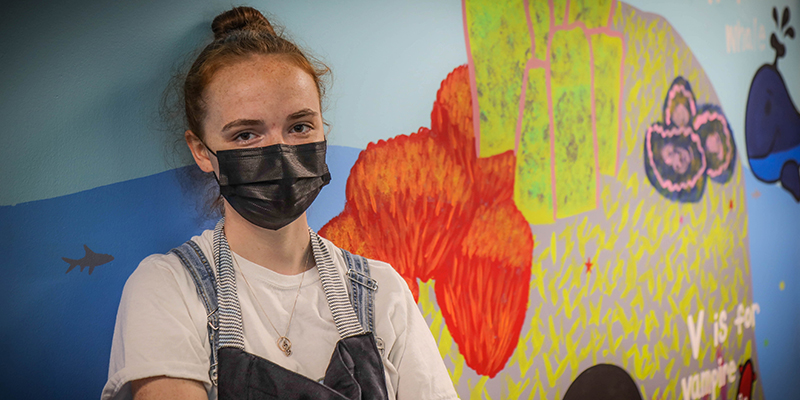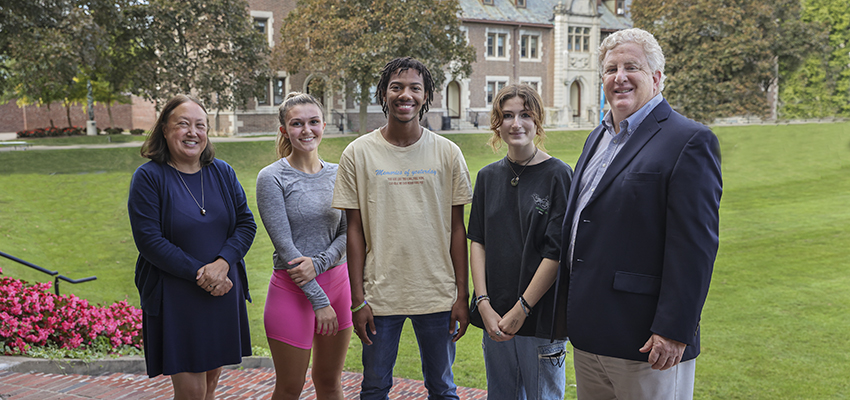
HWS News
2 November 2021 • Arts A Homecoming for Dove's Cow V
An anonymous donation returns a watercolor painting by renowned abstract artist Arthur Dove to its hometown. Dove was a member of the Hobart Class of 1903 for two years.
In September, Cow V was sold at auction and soon will arrive at its permanent home in The Collections of Hobart and William Smith Colleges. The 1935 work by Arthur Dove was gifted to the Colleges by an anonymous donor. Dove was a member of the Hobart Class of 1903 for two years before receiving his undergraduate degree from Cornell University.
“Given the date, Cow V was painted while Dove lived in Geneva, and helps expand our collection of Dove’s regional watercolors,” says Anna Wager, visual arts curator at HWS. “Cow V is playful in a way that we don’t always associate with Arthur Dove, or with Modernism more broadly. While the cow shares characteristics with his other watercolors in our collection—a focus on line and energy, complimentary tonalites, and an understated palette, the cow is also just kind of sweet and whimsical, like the Happy Clam watercolor in our collection. The work is in its original frame, with exhibition history information on the back; this includes a label for Alfred Stieglitz’s An American Place gallery, which gives us some context for the work. This is rare, and exciting.”
Dove’s Cow I and Cow II are on display at the Metropolitan Museum of Art.
Acknowledged as America’s first abstract painter, Dove lived much of his life in Geneva, N.Y., where he took “as his subject matter the family farm and the local barnyard animals, as well as the rural landscapes and industrial areas nearby,” as the Skinner auction house notes. “Cow, painted in 1935, demonstrates Dove’s impulsive, momentary response to nature through gestural lines and washes of color.”
As a child in Geneva, Dove was influenced by his neighbor, naturalist Newton Weatherly, who taught him to hunt and fish. Weatherly, who was also an amateur musician and painter, provided Dove’s first introduction to painting. Dove attended Hobart College and later Cornell where he earned his J.D. His passion, though, was art. Dove moved to New York where he was soon in demand as a freelance illustrator, with commissions from Harper’s Magazine, Scribner’s Magazine, Collier’s, Illustrated Sporting and Dramatic News, Saturday Evening Post and Life.
In 1908, Dove traveled to Paris, where he was inspired by Fauvism and exhibited his work twice, winning high favor in the Salon d’Automne. After returning to the States, he befriended Alfred Stieglitz, a prominent New York art gallery promoter whose 291 Gallery provided a unique venue and gathering place for progressive American artists. Dove’s first solo exhibition at 291 was held in 1912, consisting of 10 pastel drawings that have come to be known as the “Ten Commandments.” The attention it received established Dove as a prominent abstract painter.
Dove spent the rest of his career developing his idiosyncratic style of formal abstraction, characterized by experimentation with color, composition and materials. Channeling his ideas about nature, feeling and pure form, Dove’s work is associated with Stieglitz’s circle of modern American artists, which included John Marin and Georgia O’Keeffe, who credited Dove with inspiring her to experiment with abstraction.
By the mid-1920s, Dove was exhibiting regularly, paralleled by the rise of Stieglitz’s new Intimate Gallery in 1925. His work continued to explore abstraction and organic forms and, in addition to paintings, he produced assemblages made of found materials. During his lifetime, Dove exhibited widely at venues including the Whitney Museum of American Art, the Museum of Modern Art, the Phillips Collection and the Museum of Fine Arts in Boston, Mass.
In 1938, while on a trip to New York to attend his exhibition, Dove became suddenly ill and his health never fully recovered. He and his wife, artist Helen Torr, bought a home in Centreport on Long Island where they would stay the rest of his life. Despite his physical limitations, he continued to work, turning to the less physically strenuous media of drawing and watercolor, and produced new work for five solo exhibitions in the 1940s. His work of this period embraces pure abstraction more fully than ever and is regarded by some to be a culmination or crystallization of his singular style and approach to abstract painting.
Dove suffered a stroke in 1946 and died, just four months after his lifelong friend and mentor Alfred Stieglitz died of a heart attack. Dove’s importance to American art has since been recognized with more than a dozen retrospective exhibitions at major museums and galleries. He has been credited with exercising an indirect influence on the first generation of Abstract Expressionists, such as Jackson Pollock and Mark Rothko, who placed similar emphasis on the artist’s subjective experience of his surroundings and on the intrinsic emotional power of color and line.
The HWS Collections house five other works by Dove, and the Colleges continue to pay tribute to his memory through the Arthur Dove Scholarship for Studio, Fine Art and Architecture, as well as the Arthur Dove 1903 Art Award, which was established in 1980 by William B. Carr. The award is used to purchase a work of art created by a student at the Colleges that in the judgment of the Awards Committee best expresses the essential spirit and ideas that Dove sought in his works.


